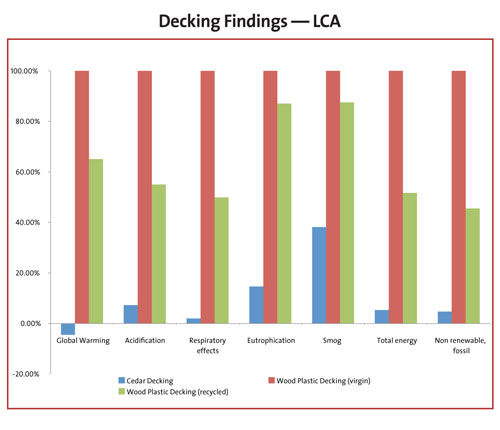Getting to Green: Life Cycle Analysis plus Forest Certification Give Western Redcedar High Marks in Sustainability
Summary of Decking and Siding Findings
In comparing western redcedar decking and siding to alterative building materials, environmental impact measures were applied consistently to each product and included: total primary energy on a cumulative demand basis, global warming potential, acidification potential, aquatic eutrophication potential, ozone depletion, smog formation potential, and human particulate (respiratory) effects.
In the study's main finding, western redcedar decking substantially outperformed composite decking in each of the seven criteria tested and was by far the product with the least environmental impact when compared with both virgin and recycled wood-plastic composite (WPC) decking products. "The seven impact measures tested typically represent a product's environmental footprint, and the findings are consistent with dozens of other LCAs that evaluated wood against other building materials," says Jennifer O'Connor, Group Leader, Energy & Environment Building Systems Program FPInnovations, Forintek Division.

Other key findings include the following:
- Even after subjecting the cedar decking results to a "worst case" scenario in which western redcedar required the replacement of 20 percent of boards in normal service and periodic application of coatings, the environmental impact results remained strongly in favor of western redcedar over a "best case" scenario for composite decking.
- Western redcedar siding had the best overall performance when compared to vinyl and fiber-cement and brick. The western redcedar received top marks in five of seven impact criteria, including "global warming potential."
- In the case of decking, western redcedar substantially outperforms WPC, regardless of the recycled plastic content in the WPC, across all the environmental metrics examined in the study.
- Western redcedar siding impact on smog and eutrophication - the criteria in which it was not the leader - can be traced directly to the use of paint, not the natural characteristics of cedar. Use of high quality paints and stains (some of which carry performance warranties) or the use of the new water-borne coatings would have a very positive impact on results.
- Total life energy of western redcedar siding can be further improved by altering end-of-life disposal practices away from the assumed practice of 100 percent landfill, to a mix of reuse, energy recovery and landfilling. While other products tested remained green house gas contributors, reusing the cedar results in the wood becoming a net "carbon sink." That practice is already reality in many communities and on high-profile projects.
Philadelphia-based architecture firm KieranTimberlake used reclaimed western redcedar on two recent award-winning projects: the Stewart Middle School at Sidwell Friends School and the Yale School of Art Gallery. At Sidwell Friends, the firm's addition and renovation transforms the 55-year-old school into a teacher of environmental responsibility by example. The exterior is western redcedar obtained from 100-year-old wine vats, which allowed for design flexibility that could not be obtained with other materials, and allowed architects to manipulate the façade for solar shading on the eastern and western sides and unify new and existing structures. Vertical plank fins are angled so that daylight penetrates deep into the building while protecting against solar gain.









